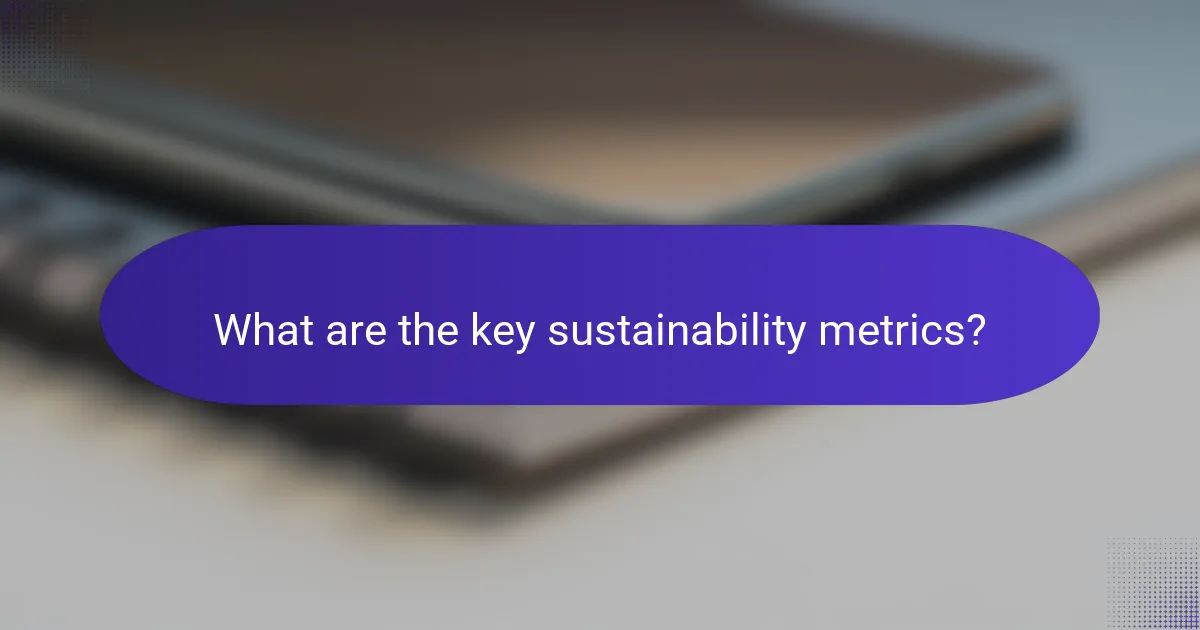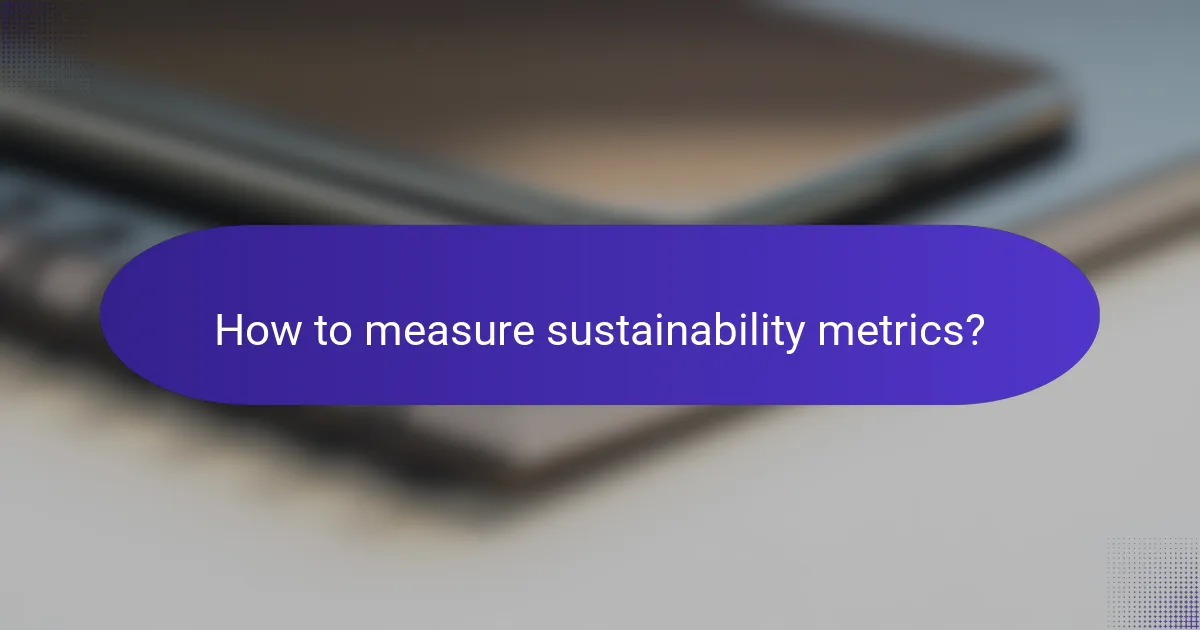Sustainability metrics are essential tools that enable organizations to quantify their environmental impact and assess their sustainability performance. By measuring factors such as carbon emissions, resource usage, and waste management, these metrics guide organizations in improving their sustainability practices and complying with regulations. Through methods like life cycle assessments and sustainability reporting, organizations can gain valuable insights that drive meaningful change.

What are the key sustainability metrics?
Key sustainability metrics are quantifiable measures that help organizations assess their environmental impact. These metrics provide insights into areas such as carbon emissions, resource usage, and waste management, guiding efforts to improve sustainability practices.
Carbon footprint
The carbon footprint measures the total greenhouse gas emissions produced directly and indirectly by an individual, organization, or product. It is typically expressed in carbon dioxide equivalents (CO2e) and encompasses emissions from energy use, transportation, and manufacturing processes.
To calculate a carbon footprint, consider factors such as energy consumption in kilowatt-hours, fuel usage in liters or gallons, and waste generation. Tools and calculators are available to help estimate these emissions, allowing organizations to identify key areas for reduction.
Water usage
Water usage metrics track the amount of water consumed in various processes, including production, cooling, and sanitation. This metric is crucial for understanding the sustainability of operations, especially in water-scarce regions.
Organizations should monitor both direct water use and indirect consumption through supply chains. Implementing water-saving technologies and practices can significantly reduce overall water usage, contributing to sustainable resource management.
Energy consumption
Energy consumption metrics quantify the total energy used by an organization, often measured in kilowatt-hours (kWh) or megajoules (MJ). This metric is vital for assessing efficiency and identifying opportunities for renewable energy integration.
To improve energy consumption, organizations can conduct energy audits, invest in energy-efficient equipment, and explore renewable energy sources like solar or wind. Setting specific energy reduction targets can also drive progress toward sustainability goals.
Waste generation
Waste generation metrics evaluate the total waste produced by an organization, including solid, liquid, and hazardous waste. Understanding waste generation is essential for developing effective waste management strategies and minimizing landfill contributions.
Organizations can implement waste reduction practices such as recycling, composting, and reusing materials. Tracking waste generation over time helps identify trends and areas for improvement, fostering a culture of sustainability.
Biodiversity impact
Biodiversity impact metrics assess how an organization’s activities affect local ecosystems and species. This includes evaluating land use, habitat destruction, and pollution, which can threaten biodiversity.
To mitigate negative impacts on biodiversity, organizations should conduct environmental assessments and engage in conservation efforts. Supporting local wildlife initiatives and sustainable land use practices can enhance biodiversity while promoting corporate responsibility.

How to measure sustainability metrics?
Measuring sustainability metrics involves assessing various environmental, social, and economic factors to evaluate an organization’s overall sustainability performance. Key methods include life cycle assessments, sustainability reporting frameworks, and data collection tools that help quantify impacts and guide improvements.
Life cycle assessment (LCA)
Life cycle assessment (LCA) is a systematic approach to evaluating the environmental impacts of a product or service throughout its entire life cycle, from raw material extraction to disposal. It considers factors such as energy use, emissions, and resource depletion, providing a comprehensive view of sustainability.
When conducting an LCA, it is essential to define the goal and scope clearly, gather data on inputs and outputs, and analyze the results to identify areas for improvement. Common pitfalls include neglecting certain life cycle stages or using outdated data, which can skew results.
Sustainability reporting frameworks
Sustainability reporting frameworks provide structured guidelines for organizations to disclose their sustainability performance and impacts. Popular frameworks include the Global Reporting Initiative (GRI), Sustainability Accounting Standards Board (SASB), and the Carbon Disclosure Project (CDP).
These frameworks help organizations communicate their sustainability efforts to stakeholders, enhance transparency, and benchmark against industry standards. It is crucial to select a framework that aligns with the organization’s goals and stakeholder expectations to ensure relevance and effectiveness.
Data collection tools
Data collection tools are essential for gathering accurate information on sustainability metrics. These tools can range from software applications that track energy consumption to surveys that assess employee engagement in sustainability initiatives.
When choosing data collection tools, consider factors such as ease of use, integration with existing systems, and the ability to generate actionable insights. Regularly reviewing and updating data collection methods can help organizations stay aligned with evolving sustainability goals and regulations.

Why are sustainability metrics important?
Sustainability metrics are crucial for assessing and improving environmental, social, and economic performance. They provide a framework for organizations to measure their impact, comply with regulations, and enhance their overall sustainability efforts.
Regulatory compliance
Many countries have established regulations that require businesses to report on their sustainability practices. Compliance with these regulations not only avoids penalties but also demonstrates a commitment to responsible practices. For instance, the European Union’s Green Deal mandates stricter emissions reporting, pushing companies to adopt robust sustainability metrics.
Organizations should regularly review local and international regulations to ensure they meet compliance standards. This proactive approach can help identify potential risks and opportunities for improvement in sustainability practices.
Brand reputation
Strong sustainability metrics can significantly enhance brand reputation. Consumers increasingly prefer to support companies that demonstrate environmental responsibility and social equity. Brands that effectively communicate their sustainability efforts often see increased customer loyalty and market share.
To build a positive reputation, businesses should transparently share their sustainability metrics through reports and marketing materials. Engaging with stakeholders and addressing their concerns can further strengthen trust and brand image.
Operational efficiency
Implementing sustainability metrics can lead to improved operational efficiency by identifying waste and optimizing resource use. For example, measuring energy consumption can highlight areas for reduction, resulting in lower costs and a smaller carbon footprint. Companies often find that sustainable practices can lead to significant savings over time.
To maximize operational efficiency, organizations should regularly analyze their sustainability data and set specific, measurable goals. This continuous improvement process can drive innovation and enhance overall performance, benefiting both the environment and the bottom line.

What are the applications of sustainability metrics?
Sustainability metrics are used to evaluate and improve environmental, social, and economic performance across various sectors. They provide a framework for organizations to track their progress, make informed decisions, and communicate their sustainability efforts effectively.
Corporate sustainability strategies
Organizations utilize sustainability metrics to develop and refine their corporate sustainability strategies. By measuring key performance indicators (KPIs) such as carbon emissions, energy consumption, and waste generation, companies can identify areas for improvement and set measurable goals.
For instance, a company might aim to reduce its carbon footprint by 20% over five years, using metrics to track progress. This data-driven approach not only enhances operational efficiency but also strengthens brand reputation among environmentally conscious consumers.
Supply chain management
Sustainability metrics play a crucial role in supply chain management by assessing the environmental and social impacts of sourcing and logistics. Companies can evaluate suppliers based on their sustainability practices, ensuring that they align with corporate values and regulatory standards.
For example, a business might prioritize suppliers who use renewable energy or adhere to fair labor practices. By integrating sustainability metrics into procurement processes, organizations can mitigate risks and enhance the overall sustainability of their supply chains.
Investment decision-making
Investors increasingly rely on sustainability metrics to guide their investment decisions. These metrics help assess the long-term viability and risk profile of companies, particularly in sectors facing regulatory pressures or shifting consumer preferences.
For instance, funds may focus on companies with strong environmental performance, as these are often seen as more resilient and better positioned for future growth. By incorporating sustainability metrics into their analysis, investors can make more informed choices that align with their values and financial goals.

What frameworks support sustainability metrics?
Several frameworks support sustainability metrics, providing structured approaches for organizations to measure and report their environmental, social, and governance (ESG) performance. These frameworks help standardize reporting, making it easier for stakeholders to assess sustainability efforts.
Global Reporting Initiative (GRI)
The Global Reporting Initiative (GRI) is one of the most widely used frameworks for sustainability reporting. It offers guidelines that help organizations disclose their impacts on the economy, environment, and society in a transparent manner.
Organizations using GRI can select from a range of indicators tailored to their specific sector and operational context. This flexibility allows for meaningful comparisons across industries while ensuring that relevant sustainability issues are addressed.
To effectively implement GRI, companies should engage stakeholders in the reporting process and focus on materiality—reporting on issues that significantly affect their business and stakeholders. Regular updates and adherence to GRI standards can enhance credibility and stakeholder trust.
Carbon Disclosure Project (CDP)
The Carbon Disclosure Project (CDP) focuses specifically on climate-related disclosures, encouraging companies to measure and manage their greenhouse gas emissions. CDP provides a platform for organizations to report their environmental data, which is then made available to investors and other stakeholders.
Participating in CDP can help organizations identify risks and opportunities related to climate change, ultimately guiding them towards more sustainable practices. Companies are assessed based on their transparency and performance, which can influence investor decisions and public perception.
To maximize the benefits of CDP participation, organizations should establish clear emission reduction targets and regularly monitor their progress. Engaging with stakeholders and integrating feedback into sustainability strategies can further enhance the effectiveness of their climate initiatives.

How do organizations implement sustainability metrics?
Organizations implement sustainability metrics by establishing clear frameworks and processes to measure their environmental and social impacts. This involves setting specific goals, collecting relevant data, and regularly assessing progress to ensure accountability and improvement.
Setting measurable goals
Setting measurable goals is crucial for effective sustainability metrics. Organizations should define specific, quantifiable objectives that align with their overall sustainability strategy, such as reducing carbon emissions by a certain percentage within a set timeframe.
Consider using the SMART criteria—Specific, Measurable, Achievable, Relevant, and Time-bound—to create goals that are realistic and trackable. For example, a company might aim to decrease water usage by 20% over five years, which provides a clear target to work towards.
Common pitfalls include setting vague goals or failing to involve key stakeholders in the goal-setting process. To avoid these issues, ensure that all relevant departments contribute to the goal formulation and that the goals are communicated clearly throughout the organization.



